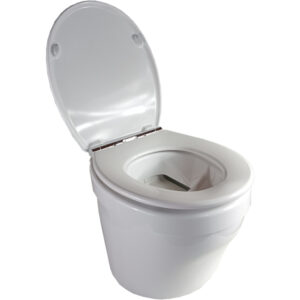Boat toilet
Discover our wide selection of compact and waterless toilets, specially designed for life on the water. No hassle with chemicals, no need for water. With several models to choose from, you are sure to find the perfect dry toilet for your boat. Make your boating experience comfortable and environmentally friendly. Discover our dry toilets for boats today!
Showing all 6 results
-
Standing Comfort Mo Dry Toilet Ecosave
€899,00Original price was: €899,00.€775,00Current price is: €775,00. Bekijk product
What is the difference between a dry toilet and a compost toilet?
A dry toilet is a type of toilet that uses no water and no chemicals to drain the faeces. Instead, the stool is separated between urine and faeces, and the feces are dried and urine sent to the holding tank or incineration.
A compost toilet uses a special kind of bacteria to break down the faeces. This process ensures that the faeces are eventually converted into compost, which can then be used as fertilizer for gardens and plants.
Are dry toilets environmentally friendly?
Yes, dry toilets are environmentally friendly as they do not use water and do not release waste into water treatment systems. In addition, the compost or ash produced by the toilet can be reused as fertilizer for plants.
Are dry toilets smelly?
No, dry toilets are not necessarily smelly. Dry toilets can be kept odorless through the use of special bacteria, air ventilation and regular maintenance.
Can I use a dry toilet in my home?
Yes, many people do this because they save a lot of money. Regular toilets use 6 to 8 liters of water per flush, while a dry toilet uses no water. This saves you a lot of money.
A dry toilet is a type of toilet that uses no water and no chemicals to drain the faeces. Instead, the stool is separated between urine and faeces, and the feces are dried and urine sent to the holding tank or incineration.
A compost toilet uses a special kind of bacteria to break down the faeces. This process ensures that the faeces are eventually converted into compost, which can then be used as fertilizer for gardens and plants.
Yes, dry toilets are environmentally friendly as they do not use water and do not release waste into water treatment systems. In addition, the compost or ash produced by the toilet can be reused as fertilizer for plants.
No, dry toilets are not necessarily smelly. Dry toilets can be kept odorless through the use of special bacteria, air ventilation and regular maintenance.
- Your newly acquired solar energy is free, so it is recommended to use electricity as much as possible instead of other energy sources.
- Selling back energy: Energy that you generate, but which you do not use yourself, is supplied back via the power grid. For example, this green energy can be used for households that do not generate their own electricity and we all use more sustainable energy. Your energy supplier gives you a feed-in fee for this.
- When purchasing your solar panels, you have made a certain choice to arrive at a number of panels. You may have decided to generate more energy than you consume or maybe just enough. In the latter case, it is wise to spread your energy consumption over the day. This means that you don’t have to turn on all your devices at the same time.
Yes, many people do this because they save a lot of money. Regular toilets use 6 to 8 liters of water per flush, while a dry toilet uses no water. This saves you a lot of money.








